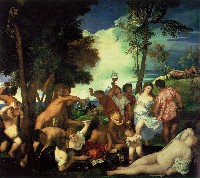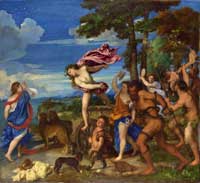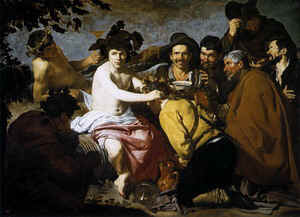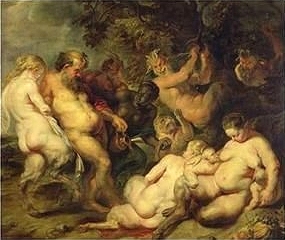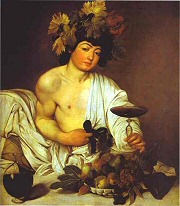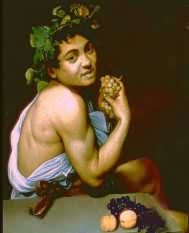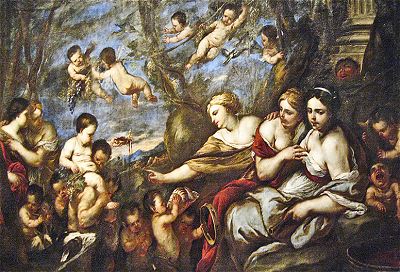
click to enlarge |
|
A Bacchanal
Luca Giordano “Wine, Women and Song”
Docent to Docent Presentation,
January 29, 2008
by Lin Vertefeuille |
I. Introduction
The usual depiction of a bacchanal with “wine, women and song” is a physical
manifestation of a profound context of worship which has influenced visual, performing
arts and literature through the ages. Bacchanalia is a subject worthy of representation in
art, but often misinterpreted from our contemporary viewpoint. Luca Giordano’s
painting is more clearly understood by exploring the subject of Bacchanalia and its Cult
of Dionysus. This requires us to examine Dionysian mythological origins, bacchanal
iconography, history, the reality of its spiritual importance and religious practice. It
is my expectation that a broad comprehensive approach will give an appreciation of the
bacchanal theme and provide specific information to be used in interpreting Luca
Giordano’s painting. I hope Luca Giordano’s wonderful Bacchanal will be
understood and most of all enjoyed.
II. Terminology
Bacchus and Dionysus are interchangeable names of the same deity. Bakchos
was his common Greek name and his followers were called Bacchoi. The Roman
adaptation was Bacchus. Dionysus also derived from Greek was a term for
“son of Zeus.” The Cult of Dionysus and the rites of his mysteries were
practiced in both public festivals and in more secretive bacchanals.
III. Mythological Origins of Dionysus
Dionysus’ birth was very strange even for a mythological deity. He was conceived in a
sexual relationship between Zeus and the mortal, Semele, daughter of Cadmus, King of the
Greek city of Thebes. Zeus made a passionate but irrevocable vow to grant her any wish.
Hera, the vindictive wife of Zeus, used his vow as an opportunity to destroy her. She
tricked Semele into wishing to behold her lover, Zeus, unaware that mortals could never be
allowed to see him. When Zeus appeared in a thunderbolt, Semele was instantly consumed by
fire and sent into Hades. At the moment of her destruction, Zeus took her undeveloped
child, Dionysus, and placed him on his thigh to complete his gestation. After he was born
(again) Zeus gave the infant Dionysus to Hermes to hide from Hera’s wrath. Hermes
placed Dionysus into the nurturing care of the gentle Nymphs of Mt. Nysa.
It was said that later in gratitude Zeus placed the Nymphs in the sky as the star group Hyades
and when they appear near the horizon, they bring gentle rains that nourish grapes.
Dionysus invented cultivation of grapes and wine. He was tutored by an aged satyr,
Silenus, who remained his closest companion. Dionysus traveled the world spreading
viticulture and viniculture and the mysteries of his worship.
IV. Mythological Tales of Dionysus
There were tales of his travels that illustrated his benevolent nature. In one story he
went on a dangerous journey into the underworld and led his mother, Semele, out of Hades
(raised her from the dead) so she could dwell in Mt. Olympus.
In another episode, Ariadne, daughter of the Minoan King who helped Theseus escape the
labyrinth, was abandoned by him when she fell asleep on the Island of Naxos. Dionysus
found the desolate Ariadne and feeling compassion, feel in love and rescued her. Dionysus
and Ariadne were popular romantic subjects for artists. Note the ormolu clock of
“Sleeping Ariadne” in Ca d’Zan.
During Dionysus’ travels when people rejected his worship he could be a god of cruel
retribution. The story of Pentheus in Euripides’ play, Bacchae, related the most
horrific punishment in all Greek mythology. Dionysus returned to the city of his birth,
but his cousin, Pentheus King of Thebes, refused to believe he was a deity and son of his
aunt Semele. After mocking Dionysus and attempting several times to imprison him, he
finally incurred Dionysus’ anger. Pentheus’ mother Agave and other Theban women
became Maenads under Dionysus’ spell and roamed the forest as crazed wild women. When
Pentheus pursued them, the Maenads thinking he was a mountain lion, rushed in and tore him
limb from limb. When Dionysus restored their sanity, the sobered Agave discovered she had
dismembered her own son. These tales illustrated that the dual nature of Dionysus was
characteristic of wine – it could be both beneficial and detrimental.
V. The Bacchanal Retinue
Dionysus traveled with a very unique entourage of Bacchanalia creatures and associates
– quite a cast of characters.
Silenus - the oldest of Satyrs was Dionysus’ debauched mentor and
most frequent companion. He was usually depicted as bearded, drunken, sometimes with
either goat or horse ears, hooves and tail. Although prophesy was attributed to him, most
often he was perpetually stupefied with wine, unable to distinguish truth from falsehood.
Pan – was a pastoral deity who made flocks fertile so appropriately
he had horns, legs and ears of a goat. Although he was physically unattractive, he had
amorous tendency to seduce nymphs. He could be mischievous and sometimes ill tempered
often frightening unwary forest travelers. He was known for playing his reed pan flute and
for blowing into a conch shell. When he blew the conch shell the sound emitted created so
much anxiety and agitation that our word panic is derived from Pan.
A surprising reference to Pan was told by Spanish writer, Rodrigo Caros in a book in 1634.
In his history of Seville he described how Bacchus founded Cadiz and ruled until his
companion, Pan, took over as regent. The region therefore became known as Pania
which later became Hispania. It was said that Philip IV considered himself as a
successor to Bacchus.
Maenads or Bacchantes – were the most fearsome in the bacchanal
retinue. They were mortal wild- haired women followers who roamed mountains and forests
adorned in ivy and animal skins waving the thyrsos (reed tipped with pine cone). While
under Dionysus’ influence, they danced and worked into an ecstatic frenzy capable of
tearing apart animals with their bare hands - definitely someone to avoid meeting on such
an occasion.
Satyrs, Sileni, fauns, centaurs – were forest participants in the
Bacchanal. Satyrs were sensuous creatures usually part man part goat
(hooves, horns, ears, tail) who danced, played music and certainly knew how to party.
Ancient Greek and Romans depicted them as ugly with beards, snub noses and bulging
foreheads. Sileni were similar to satyrs, but were older and often had
either horse or goat legs horns, ears, and tail. Fauns were gentler,
handsome young males with discrete horns and goat ears, tail and usually human legs. They
were the most attractive of the group and popular in sculpture. Centaurs
sometimes in Bacchanalia were creatures with the head and torso of a man and body of a
horse and were sexually aggressive.
Nymphs – were beautiful maiden-creatures who in habited, the sea,
rivers, woods, trees, meadows and mountains as followers of various deities. In
Bacchanalia they were sensual, scantily clad or nude usually “partying” with
satyrs and fauns.
Putti – boy- babies were used as an art form to display by their
actions life forces, emotions, sensations - the spirit expressed in a scene. They were
frequently part of a Bacchanal, usually very busy and active. A putto sometimes hid behind
an ugly mask of Silenus playing boogeyman trying to scare other putti. Such a putto is a
called a Larvate and represented empty fright, silly unfounded fears or tension
caused by a disguised putto trying pretend to be fearsome. Other charming, devotional
putti dutifully tend grape vines and make wine. Satyr-putti cavort in
wild abandon, playing instruments, dancing and often drinking in excess displaying the
physical effects of wine illustrating its mental alteration.
Dionysus – in his earliest rendering in Greece was a bearded
Zeus-like figure, but soon evolved into an attractive long-haired Apollo-like man. In
Euripides’ tragedy Bacchae, the story of Pentheus, Dionysus was described as
“foreign and woman-like.” Over the centuries artists’ renditions have been
varied: an infant, handsome lover of Ariadne, effeminate and even fat full
of the good life. He usually appeared good-natured, perhaps grinning and enjoying the
celebration. In ancient times he was shown offering wine, but never drinking it. His head
was crowned with ivy (immortal symbol) or grape leaves and often wore leopard or lion
skins.
VI. Bacchanalia Iconography
Besides his unusual retinue, Bacchus had special attributes and symbols.
The Dithyramb was poetry in choral song and dance praising Dionysus and
essential in the ritual. Maenads sang and danced and satyrs played musical instruments
(tambourine, pipes, clappers) thereby enhancing the intoxication of the wine. Loud
music provided passion in the reverie and created the spirit of wild abandon.
The thyrsos was the iconic fertility symbol of the Cult of Dionysus
heralding the Bacchic celebration. It was carried by either Bacchus or Maenads. The
thyrsos was a staff tipped with a pine cone and sometimes wrapped in ivy or grape leaves.
Goats were Dionysus’ sacrificial animal. They are present in most
bacchanal scenes usually being restrained by the horns or ridden by satyr-putti trying to
protect the tender grape leaves from being eaten. Roman poet, Virgil said, “Beware of
the rough-toothed goat.” Goat skins were used to hold wine.
Snakes sometimes in Bacchic celebrations were possibly from Minoan
tradition as symbols of rebirth and rejuvenation because snakes shed their skins. In
ancient periods in this context they were not symbols of evil.
Masks relevant to Greek theater were important attributes of Dionysus.
(see History…).
Leopard skins were worn by Dionysus and he traveled by chariot pulled by
lions. Wild cats with their capricious behavior symbolized Dionysus’ irrational wild
nature. Hunt animals as dogs referred to the story of Dionysus driving lions from Mt.
Nysa.
VII. History of the Cult of Dionysus and Bacchanal
The origin of the Cult of Dionysus is unknown. Fertility worship was prevalent in early
Bronze Age Mediterranean area. Scholars postulate that some Bacchic elements may have
their source in cultures of Asia Minor (Phrygian, Lydian) and in the Minoan civilization
of Crete. It has been substantiated that by 1250 BCE, Dionysus was accepted as a god and
rituals were part of Mycenaean religion.
However, Dionysus achieved greatest prominence in Classical Greece and festivals and
bacchanals were ubiquitous throughout the Greek World. In 500 – 400 BCE, the Great
Dionysia was the foremost celebration of civic pride in Athens and was so important that
the entire population was encouraged to attend including women, who in Greek society were
usually cloistered in their homes. The Great Dionysia was a competition between
poet-playwrights creating the great tragedies Aeschylus, Sophocles and Euripides. Greek
theater began with the Dithyramb, poetry of praise sung by a chorus that evolved into
character speaking parts. The competitive prize was a sacrificial goat. The word tragedy
in Greek meant “goat song.” It is ironic that today Bacchanalia has a
connotation of orgy and immorality, but for Athenians it was an important venue for civic
lessons in morality. Aristotle pointed out that its ritual function was to purge
spectators of their emotions of pity and fear through their vicarious participation in the
drama. It is interesting that Dionysus, not Apollo, was the inspiration for Greek Drama.
Apollo represented the rational and civilized side of man’s nature. Dionysus was the
embodiment of man’s irrational, passionate side that unleashed the creative spirit.
He suffered greatly when the vine was pruned just as the tragic hero/heroine suffers
trying to overcome obstacles in their moral struggles.
In the Roman Era the Dionysian Cult may have arrived in Italy through southern Etruria
between 400 – 200 BCE. Roman writer, Livy, in his history of Rome (29BCE) related
that the Senate in the Roman Republic in 186 BCE banned the bacchanal because of
immorality. This led to persecution of the Bacchoi (members) which forced the Cult to go
underground, later to reemerge even stronger. Most scholars believe the charges leveled
against them were mostly false or exaggerated. The unsanctioned Cult had been gaining in
popularity especially among the underclass of society and was considered suspect by the
Senate because it wasn’t under their complete control. This was a period after the
Second Punic War when ethnic fear could be evoked of anything “foreign.” The
ancient Italic deity of fertility and agriculture was Liber Pater. Liberalia was an
ancient festival which celebrated young men’s “rite of passage” by removing
their bulla (lucky charm) and exchanging their toga of childhood for the white toga of
adulthood. Gradually in Latium, Liber became assimilated with Bacchus. In the early
Christian Era, Eastern Roman Emperor, Theodosius II (401 – 450CE) by law ended the
bacchanal and all Dionysian worship
VIII. Bacchanalia Celebration in Greco- Roman World – “Wine, Women and
Song”
The actual ritual practice of the bacchanal in the Greco-Roman world varied by region and
cannot be described with singular complete certainty because the mysteries were not
written down and were known only to the Bacchoi. However some Bacchic characteristics were
known and universal. It was celebrated at night, outside in a wooded location lit by
torches and led by Bacchantes (priestesses) and Bacchants (priests). The thyrsos (reed and
pine cone) was carried by the celebrants. Women were essential
members of the Bacchoi in the role of Maenads or Bacchantes. Sometimes they practiced
animal sacrifice but it is doubtful Maenads tore animals apart in wild frenzy. Music was
another necessary element of the rite and it was used in the
dithyramb praises of Dionysus in song and dance. Loud rhythmic
sounds intensified the euphoria. Wine liberally drunk gave Bacchoi
the exultant power of feeling divine. Wine meant that the god was not only outside them,
but when consumed he was within them too. Sexual involvement may have been a component of
the activity but it was not a necessary inclusion in
the ceremony. The reverie of “wine, women and song” was important because it
represented Dionysus’ wild spiritual release and freedom. The Bacchanal was practiced
by people of all social classes, but it was especially popular with the disadvantaged
because it didn’t require expensive votives, women could participate and worshippers
did not need a temple.
IX. Theology of Bacchanalia
Worship in the Bacchanal had obvious pleasurable orgy-like aspects, but it was the
Cult’s theology that made Dionysus such an important god in ancient societies.
Dionysus, a fertility deity, was life and rebirth. He was the vine painfully and severely
pruned, left as bare stock to emerge alive again in joyful resurrection. He had rescued
his mother from death. He was assurance that death didn’t end all. He was the
expectation that the soul lived on forever. A poignant reference to this was in a letter
written by the Greek writer, Plutarch, 80 CE, to his wife after news of the death of his
little daughter:
“About that which you have heard, dear heart, that the soul once
departed from the body
vanishes and feels nothing, I know that you give no belief to such assertions because of
those sacred and faithful promises given in the mysteries of Bacchus which we who are
of that religious brotherhood know. We hold it firmly for an undoubted truth that our soul
is incorruptible and immortal. We are to think (of the dead) that they pass into a better
place and a happier condition. Let us behave ourselves accordingly, outwardly ordering
our lives, while within all should be purer, wiser, incorruptible.”
(Mythology, Timeless Tales of Gods and Heroes, Edith Hamilton)
X. Biography of Luca Giordano
Luca Giordano was born in Naples in 1634 and died there in 1705. He was the son of the
painter Antonio Giordano (1597-1683). Luca was one of the most celebrated draughtsman and
painter of the Neapolitan baroque whose oeuvre included religious, mythological paintings
and many fresco cycles in palaces and churches. He painted in Naples, Rome, Venice,
Florence and later in Spain. Early in life he was influenced by Ribera and his work in
Naples reflected Neapolitan taste in art. In Rome he studied the work of da Cortona, Preti
and Rubens. He created his own style bringing exuberant color and light into his work.
Rubens’ paintings made a lasting impression on him as shown in the treatment of faces
in his figures. In admiration of him, Giordano painted Rubens Painting an Allegory of
Peace. He was a respected fresco artist and
painted altar pieces in Venice and vaults and a dome in Florence. He painted Bacchanals
and other mythological subjects including A Triumph of Bacchus (untraced) for
Cosimo III de Medici. It was said in Florence he used two styles – baroque in
religious subjects and an elegant classicism in secular decorative work. He was in great
demand as a decorative artist and was called twice by Philip IV of Spain, but both times
he cited pressing affairs at home. When Giordano was sixty years old, Charles II was able
to use leverage to bring him to Spain. His son’s political appointment would only be
renewed if Luca Giordano agreed to paint for Charles II in Spain. His commitment of nearly
ten years in Spain eventually advantaged other family members. He frescoed the many vaults
at the Escorial, scenes in monasteries, churches and the sacristy ceiling of the Toledo
Cathedral. His speed of execution and huge output earned him the nickname “Luca Fa
Presto.” His legendry speed and capacity to improve was amusingly expressed by the
Prior of the Escorial who wrote Charles II the following:
“ Today your Giordano has painted ten, eleven, twelve figures three
times life
size, plus the Powers, Dominions, Angels, Seraphim and Cherubim that go
with them and all the clouds that support them. The two theologians he has
at his side to instruct him in the mysteries are less ready with their answers
than he is with his questions, for their tongues are too slow for the speed of
his brush. (Grove, Dictionary of Art).
After his death he was considered a versatile painter who imitated other
styles. However, Francesco Solimena, his pupil-friend, understood and appreciated
Giordano’s creativity and absorbed his painting style.
XI. Other Bacchic Art in the Ringling Museum
The Ringling Museum has other Bacchic works of art. Portrait of a young Aristocrat,
SN 380, by Jean-Marc Nattier (1730) in Gallery 15 is an amusing depiction of a chubby male
aristocrat playing the court role of Bacchus. In his right hand he holds a Thyrsos and in
the left a cup of wine. He is draped in leopard skin with a live leopard by his side.
Many Ringling Chiurazzi “cast bronzes” are part of “the cast of
Characters” in Bacchanalia. The Elder and Younger Furietti Centaurs (from
Hadrian’s Villa) greet you at the entrance of the Art Building. Four others are
placed tantalizingly on the loggia. The Satyr with Young Bacchus, Drunken
Faun and Sleeping Faun reside on the North Loggia. Dionysus with Grapes and Goat,
known as “Rosso Antico” in the book, Taste and the Antique, is standing
in the beginning of the South Loggia.
XII. Background on Ringling Museum’s A Bacchanal by Luca Giordano
“A Bacchanal Fete” SN 161 was purchased by John Ringling as a Luca
Giordano painting in December 1929 from the Collection of Jean Desvignes, Paris, sold at
the American Art Association NYC. Suida in 1949 designated it as one of six
Giordano’s (SN 156,157, 158, 159 160, 161) and Susannah and the Elders SN
162 as “Studio of Giordano” although originally attributed to Titian. Tomory in
1976 referred to “A Bacchanal” SN 161 and Susannah and the Elders
SN 162 as a copies “after Giordano.” He agreed with four of Suida’s
Giordano’s, but Jacob and Raphael at the Well SN 158 he attributed to
Francesco Solimena. Tomory stated that A Bacchanal had conservation in 1947-49:
major losses on left side and center on lower left of canvas. It was stated that A
Bacchanal, had elements from both Ribera and Giordano, but was possibly painted by a
studio assistant or an independent Neopolitan.
In the present registrar A Bacchanal is attributed to Luca Giordano. The Ringling
Museum has five paintings by him:
SN 156 Adoration of Shepherds
SN 157 The Flight into Egypt
SN 159 Allegory of Faith and Charity
SN 160 Mars and Venus with Cupid
SN 161 A Bacchanal
Jacob and Rachel at the Well SN 158 is attributed to Francesco Solimena and Susannah
and the Elders SN 162 as “in the style of Giordano.”
Recently Michelle Scalera did a ten month restoration of the Bacchanal painting. It had
water damage in the lower portion during long term storage. She found a J signature mark
on the canvas. Luca Giordano sometimes signed his works as “Jordanus.”
XIII. Discussion of A Bacchanal, by Luca Giordano
Luca Giordano’s painting has many traditional bacchic features and is infused with
humor. Its composition has curious contrasting aspects. In the central area of the canvas,
gentle Nymphs of Nysia serenely recline in classical poise observing young Bacchus’
misbehavior. Infant Bacchus, raised onto the shoulder of a satyr, is pouring a cup of wine
onto the head of a satyr-putti below him. It is reminiscent of a toddler sitting in a high
chair overturning a cup of milk just to watch the liquid pouring out. The calm Nymphs
don’t seem very upset by his naughty behavior, although they may be whispering to
each other,” Look at what he is doing now.”
Their placidity is in contrast to the wild activity all around them. Satyr-putti are
obviously very inebriated and their grotesque faces are distorted in sloppy drunken
expressions with wine oozing from their mouths. Silenus may be a bearded sleeping figure
in the background and a similar figure appears in bacchanals by other artists. Other
satyr-putti are handling the goats,
holding them back by their horns and riding them. Musical instruments are played by
dancing satyr-putti creating the all important Bacchic din. A little pan-putti in the
center lower edge, is blowing a conch shell. This is in reference to Pan’s panic,
but in this situation the shell blown by a little putti is a lesser panic or disturbance.
This symbolizes frenetic spirit in the scene. Dogs appear among the throngs as Bacchic
symbols of hunting and wild nature. The foliage is thick and darker than in an idyllic
pastoral scene. All this wild nosy “rave” below is contrasted by gossamer-winged
putti fluttering above faithfully tending the grapes.
XIV. Bacchic Theme by Other Artists
Luca Giordano and many of the great artists of the 1400s – 1700s had their own
creative expressions of the Bacchic theme. Therefore paintings, engravings and sculptures
of this subject were represented in so many different ways. Michelangelo sculpted both a
young Bacchus and a drunken Bacchus and drew a Children’s Bacchanal.
Titian’s The Andrians - Bacchanal) (fig.1) and Bacchus and Ariadne
(fig.2) painted for Alfonso d’ Este were described as joyful having delicacy and good
taste.
Later The Andrians was acquired by Philip IV. Very
different is Diego Velazquez’s painting The Triumph of Bacchus (fig.3), a
scene with drunken Spanish peasants. Others referred to it as “The Triumph of Bacchus
in burlesque” and later it was known as “The Topers.” This painting was
commissioned by Philip IV and it demonstrates, as with the Titian, his interest in the
subject. P.P. Rubens created The Bacchanal (fig.4) with a very unflattering image
of the debauched Silenus and his consorts. Caravaggio’s Bacchus, 1596-97
(fig.5) and his Self-Portrait as Bacchus, 1593-94 (fig.6) couldn’t be
more different. His later Bacchus is exotic, Japanese-looking, white, soft and
effeminate. His Self-Portrait is unclean, sickly perhaps indicative of the
influence wine had in his personal life contributing to his propensity for getting into
trouble. Luca Giordano and many other artists give us pleasure with their unique
interpretations Bacchanalia.
ringlingdocents.org
|

